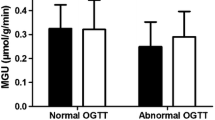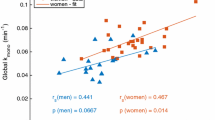Abstract
Background. Our objective was to determine, in the hearts of women with type 1 diabetes mellitus (T1DM), whether the fate of extracted glucose is altered and, if so, what the impact of dobutamine is on myocardial substrate metabolism. In experimental models of T1DM, myocardial glycolysis and glucose oxidation are reduced with the impairment becoming more pronounced with dobutamine. Whether similar changes occur in humans with T1DM is unclear.
Methods and Results. Myocardial perfusion, oxygen consumption, and glucose and fatty acid metabolism were measured with positron emission tomography in 19 women, 7 normal volunteers (NVs) and 12 with T1DM. The NVs and 6 T1DM (DM1) patients were studied under baseline metabolic conditions and 6 T1DM patients were studied during hyperinsulinemic-euglycemic clamp (DM1-C), both at rest and during dobutamine. At rest, myocardial glucose uptake, glycolysis, glycogen storage, and oxidation were reduced by similar levels in DM1 patients compared with NVs (P<.05). During dobutamine, although myocardial glucose uptake was not different from DM1 patients at rest, fractional glycolysis was lower compared with NVs or DM1-C patients and reflected a lower glucose oxidation rate (P<.001). Measurements of myocardial glucose metabolism at rest and during dobutamine were comparable between NVs and DM1-C patients. During dobutamine, myocardial fatty acid uptake and oxidation increased in all 3 groups.
Conclusions. In women with T1DM, (1) myocardial glucose metabolism is impaired downstream from initial uptake, (2) these abnormalities become more pronounced with dobutamine and are paralleled by an increase in myocardial fatty acid metabolism, and (3) insulin restores glucose metabolism to levels observed in normal control subjects.
Similar content being viewed by others
References
Avogaro A, Nosadini R, Doria A, Fioretto P, Velussi M, Vigorito C, et al. Myocardial metabolism in insulin-deficient diabetic humans without coronary artery disease. Am J Physiol 1990;258:E606–18.
Doria A, Nosadini R, Avogaro A, Fioretto P, Crepaldi G. Myocardial metabolism in type 1 diabetic patients without coronary artery disease. Diabet Med 1991;8 Spec No:S104–7.
Herrero P, Peterson LR, McGill JB, Matthew S, Lesniak D, Dence C, et al. Increased myocardial fatty acid metabolism in patients with type 1 diabetes mellitus. J Am Coll Cardiol 2006;47:598–604.
Randle PJ, Garland PB, Hales CN, Newsholme EA. The glucose fatty-acid cycle. Its role in insulin sensitivity and the metabolic disturbances of diabetes mellitus. Lancet 1963;13:785–9.
Rodrigues B, Cam MC, McNeill JH. Myocardial substrate metabolism: implications for diabetic cardiomyopathy. J Mol Cell Cardiol 1995;27:169–79.
Severson DL. Diabetic cardiomyopathy: Recent evidence from mouse models of type 1 and type 2 diabetes. Can J Physiol Pharmacol 2004;82:813–23.
Duncan JG, Fong JL, Medeiros DM, Finck BN, Kelly DP. Insulinresistant heart exhibits a mitochondrial biogenic response driven by the peroxisome proliferator-activated receptor-alpha/PGC-1alpha gene regulatory pathway. Circulation 2007;115:909–17.
Finck BN, Han X, Courtois M, Aimond F, Nerbonne JM, Kovacs A, et al. A critical role for PPARalpha-mediated lipotoxicity in the pathogenesis of diabetic cardiomyopathy: Modulation by dietary fat content. Proc Natl Acad Sci U S A 2003;100:1226–31.
Finck BN, Lehman JJ, Leone TC, Welch MJ, Bennett MJ, Kovacs A, et al. The cardiac phenotype induced by PPARalpha overexpression mimics that caused by diabetes mellitus. J Clin Invest 2002;109:121–30.
Monti LD, Lucignani G, Landoni C, Moresco RM, Piatti P, Stefani I, et al. Myocardial glucose uptake evaluated by positron emission tomography and fluorodeoxyglucose during hyperglycemic clamp in IDDM patients. Role of free fatty acid and insulin levels. Diabetes 1995;44:537–42.
Voipio-Pulkki LM, Nuutila P, Knuuti MJ, Ruotsalainen U, Haaparanta M, Teras M, et al. Heart and skeletal muscle glucose disposal in type 2 diabetic patients as determined by positron emission tomography. J Nucl Med 1993;34:2064–7.
Peterson LR, Soto PF, Herrero P, Schechtman KB, Dence C, Gropler RJ. Sex differences in myocardial oxygen and glucose metabolism. J Nucl Cardiol 2007;14:573–81.
de las Fuentes L, Herrero P, Peterson LR, Kelly DP, Gropler RJ, Davila-Roman VG. Myocardial fatty acid metabolism: independent predictor of left ventricular mass in hypertensive heart disease. Hypertension 2003;41:83–7.
Peterson LR, Herrero P, Schechtman KB, Racette SB, Waggoner AD, Kisrieva-Ware Z, et al. Effect of obesity and insulin resistance on myocardial substrate metabolism and efficiency in young women. Circulation 2004;109:2191–6.
Takala TO, Nuutila P, Knuuti J, Luotolahti M, Yki-Jarvinen H. Insulin action on heart and skeletal muscle glucose uptake in weight lifters and endurance athletes. Am J Physiol 1999;276:E706–11.
DeFronzo RA, Tobin JD, Andres R. Glucose clamp technique: A method for quantifying insulin secretion and resistance. Am J Physiol 1979;237:E214–23.
Young ME. The circadian clock within the heart: Potential influence on myocardial gene expression, metabolism, and function. Am J Physiol Heart Circ Physiol 2006;290:H1–162.
Bergmann SR, Herrero P, Markham J, Weinheimer CJ, Walsh MN. Noninvasive quantitation of myocardial blood flow in human subjects with oxygen-15-labeled water and positron emission tomography. J Am Coll Cardiol 1989;14:639–52.
Bergmann SR, Weinheimer CJ, Markham J, Herrero P. Quantitation of myocardial fatty acid metabolism using positron emission tomography. J Nucl Med 1996;37:1723–30.
Buck A, Wolpers HG, Hutchins GD, Savas V, Mangner TJ, Nguyen N, et al. Effect of carbon-11-acetate recirculation on estimates of myocardial oxygen consumption by PET. J Nucl Med 1991;32:1950–7.
Herrero P, Kisrieva-Ware Z, Dence CS, Patterson B, Coggan AR, Han DH, et al. PET measurements of myocardial glucose metabolism with 1-11C-glucose and kinetic modeling. J Nucl Med 2007;48:955–64.
Herrero P, Weinheimer CJ, Dence C, Oellerich WF, Gropler RJ. Quantification of myocardial glucose utilization by PET and 1-carbon-11-glucose. J Nucl Cardiol 2002;9:5–14.
Hall JL, Stanley WC, Lopaschuk GD, Wisneski JA, Pizzurro RD, Hamilton CD, et al. Impaired pyruvate oxidation but normal glucose uptake in diabetic pig heart during dobutamine-induced work. Am J Physiol 1996;271:H2320–9.
Vadlamudi RV, Rodgers RL, McNeill JH. The effect of chronic alloxan- and streptozotocin-induced diabetes on isolated rat heart performance. Can J Physiol Pharmacol 1982;60:902–11.
Chatham JC, Gao ZP, Forder JR. Impact of 1 wk of diabetes on the regulation of myocardial carbohydrate and fatty acid oxidation. Am J Physiol 1999;277:E342–51.
Chatham JC, Gao ZP, Bonen A, Forder JR. Preferential inhibition of lactate oxidation relative to glucose oxidation in the rat heart following diabetes. Cardiovasc Res 1999;43:96–106.
Ungar I, Gilebrt M, Siegel MS, Blain JM, Bing RJ. Studies on myocardial metabolism. IV. Myocardial metabolism in diabetes. Am J Med 1955;18:385–96.
Desrois M, Sidell RJ, Gauguier D, King LM, Radda GK, Clarke K. Initial steps of insulin signaling and glucose transport are defective in the type 2 diabetic rat heart. Cardiovasc Res 2004; 61:288–96.
Huisamen B, van Zyl M, Keyser A, Lochner A. The effects of insulin and beta-adrenergic stimulation on glucose transport, glut 4 and PKB activation in the myocardium of lean and obese non-insulin dependent diabetes mellitus rats. Mol Cell Biochem 2001; 223:15–25.
Lipworth BJ. Clinical pharmacology of beta 3-adrenoceptors. Br J Clin Pharmacol 1996;42:291–300.
Goodwin GW, Ahmad F, Doenst T, Taegtmeyer H. Energy provision from glycogen, glucose, and fatty acids on adrenergic stimulation of isolated working rat hearts. Am J Physiol 1998;274:H1239–47.
Soto PF, Herrero P, Kates AM, Dence CS, Ehsani AA, Davila-Roman V, et al. Impact of aging on myocardial metabolic response to dobutamine. Am J Physiol Heart Circ Physiol 2003;285:H2158–64.
Author information
Authors and Affiliations
Corresponding author
Additional information
This work was supported by grants PO1-HL-13851, R01-HL69100, and M01-RR00036 from the National Institutes of Health (Bethesda, Md).
Rights and permissions
About this article
Cite this article
Herrero, P., McGill, J., Lesniak, D.S. et al. PET detection of the impact of dobutamine on myocardial glucose metabolism in women with type 1 diabetes mellitus. J Nucl Cardiol 15, 791–799 (2008). https://doi.org/10.1007/BF03007360
Issue Date:
DOI: https://doi.org/10.1007/BF03007360




